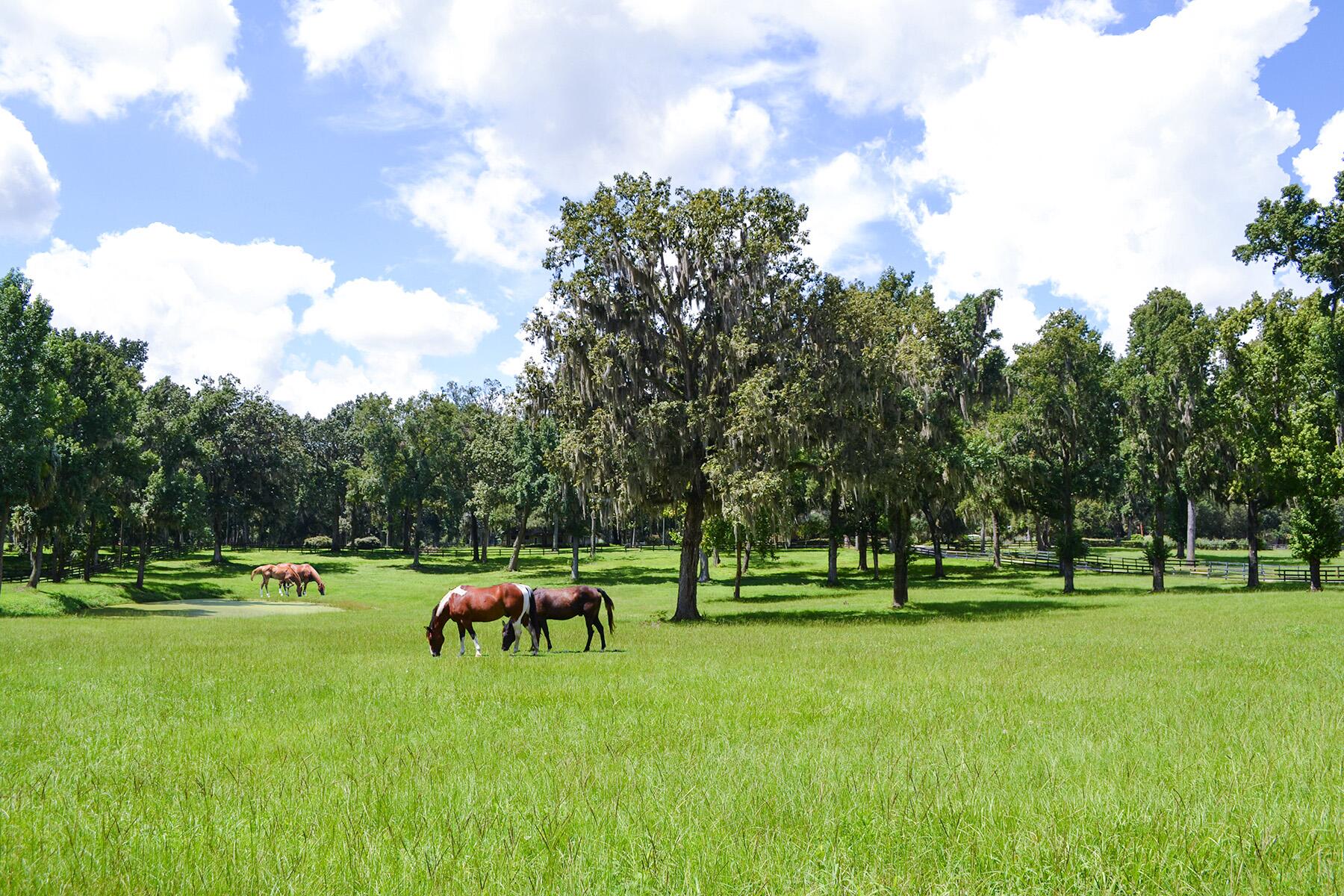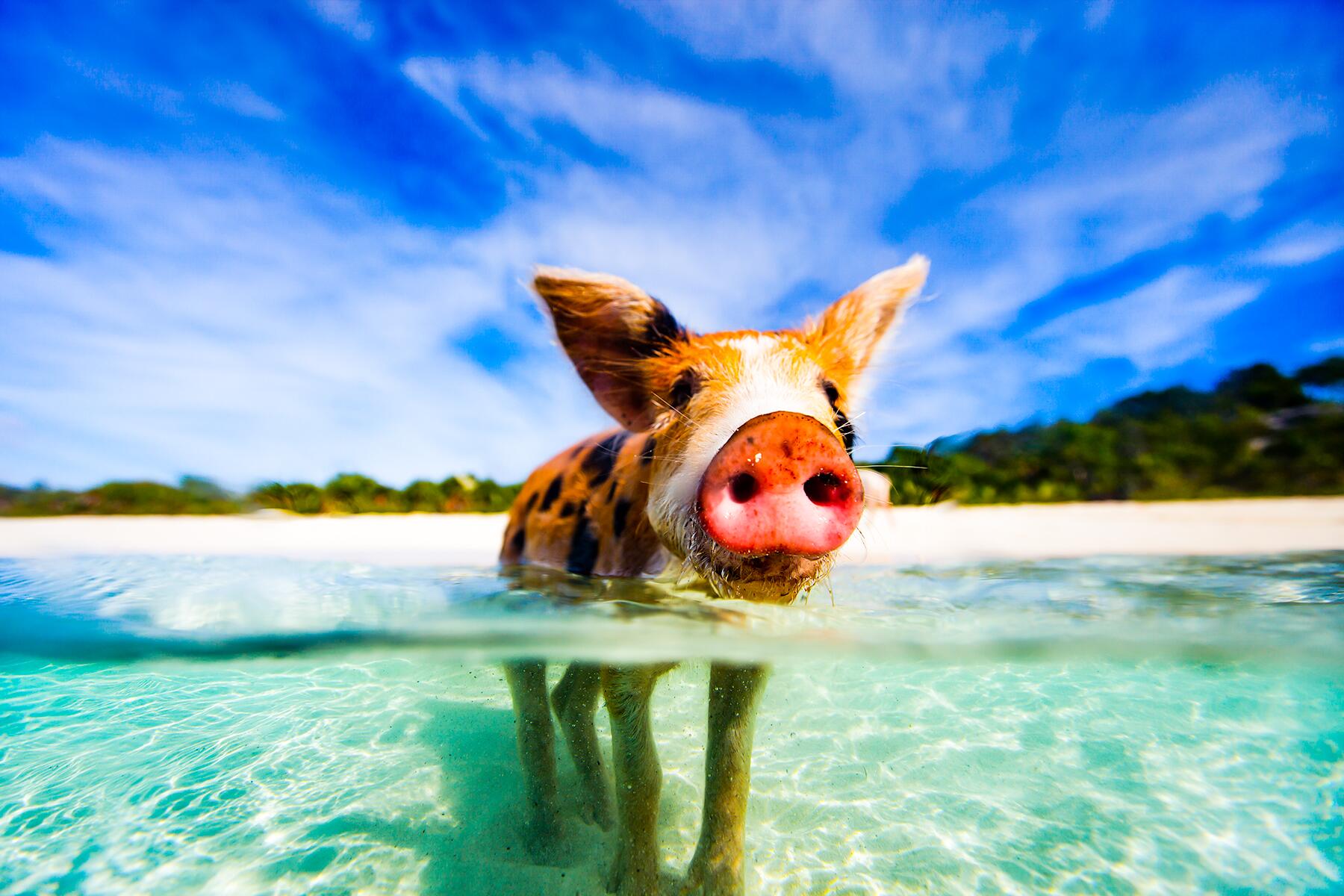The country’s top tourist attraction is undeniably weird. Is it worth it?
“R
elease the pigs!” Moses Poitier yelled from the knee-deep aquamarine water gently lapping the shore of Crystal Beach on Grand Bahama Island.
Moments later, two huge porkers trotted through an open gate set back from the sand and eagerly plunged into the sea. Five swine weighing about 400 pounds each soon entered the bathtub-warm water with our group of six tourists, including my family of four and two travelers from Poland. We clutched our iPhones and wooden sticks skewered with apples, which the pigs sniffed out like bloodhounds.
A brown pig called Jumper launched out of the water and grabbed my husband’s apples, while a pink one named Princess doggie paddled in predatory circles around my teenage daughter in pursuit of fruit. Just when I thought it couldn’t get weirder, someone exclaimed, “Oh, here comes some poop!”
Suddenly, the once-clear water became spotted with bobbing brown pig turds, the odor of excrement hanging heavy in the humid air. It was enough to make me gag, but I swallowed it down, activated my mouth breathing, and did my best to ignore the poop smeared on my daughter’s stomach. All the while, I took pictures of the melee as tour leader Poitier continued handing out new apple skewers to satiate Wilbur and company.
Recommended Fodor’s Video
Dirty Water, Aggressive Swine
Like most people on social media, I’d seen all of the pictures posted with the “piggies in paradise,” a group of swimming pigs that live on a deserted cay in the Bahamas’ Exuma islands. The blush-hued hogs walking on white sand and swimming in turquoise water are out of place yet irresistibly photogenic.
After we booked plane tickets to Nassau and started trip planning, “pig swim” topped the list of what my teens wanted to do in the Bahamas. We couldn’t do the original pig encounter since we weren’t going to the Exumas, so we opted for a similar experience on Grand Bahama.
However, when I mentioned our plans to a friend who recently swam with pigs in the Abaco islands, she said, “I have to be honest—it was absolutely disgusting. They pooped in the water everywhere and nearly attacked me as I was holding apples to give to them. I finally dumped them all at once so they’d leave me alone.”

Her experience reminded me of the time my husband and I fed rice crackers to the deer in Nara, Japan. This tourism-endorsed practice (the snacks are sold everywhere by local vendors, with feeding rules posted around town) resulted in us getting head-butted by a food-aggressive doe.
My friend’s encounter—combined with negative press from animal rights activists saying the Bahamas’ beaches are not paradise for the pigs, whose fair skin can get sunburned, are prone to overeat (and can ingest sand), and aren’t meant to swim—piqued my curiosity. I needed to check out this travel phenomenon.
The Pigs’ Backstory
Many romantic stories are floating around the internet of how the swimming pigs came to be, that they swam ashore after a shipwreck, or that sailors abandoned them on Big Major Cay with plans to return and make them into bacon. In reality, farmers in nearby Staniel Cay Village moved their pigs to the deserted islet decades ago after complaints about the smell. They boated in daily to feed the animals, which grew accustomed to swimming out to meet the dinner dinghy.
Charging tourists to watch them swim and then rewarding the cute pigs with food proved a license to print money. “Pig Beach” became one of the Bahamas’ top tourist attractions—people pay as much as $300 for the bucket list experience. Not surprisingly, copycat pig swims have sprung up around the country, like this $45 one with Celebrity Eco Adventures.
So widespread is this phenomenon people travel from the planet’s far corners to swim with the pigs, like the two tourists from Poland feeding them with us.
“We just wanted to experience this,” says Elvin Mammadov, who interrupted a three-week trip around Florida with his friend Michael Kubiak to catch a ferry from Ft. Lauderdale to Freeport, Grand Bahama, just to do the pigs. “It’s like going to Paris and not seeing the Eiffel Tower.”
Mammadov and Kubiak aren’t fussed that the Crystal Beach experience isn’t the original, and they don’t seem to mind the poopy water or the animals’ aggressiveness. In some ways, the experience is akin to a petting zoo, where children interact with goats and sheep in a supervised setting. The big difference is the pigs’ size and the unpredictability of being in the water with them.

Rules of Engagement
We’d been warned about this during a briefing before the feeding.
“The most important thing you have to worry about is if they walk on your feet,” cautioned Poitier, who repeatedly told us not to hand-feed them (hence the skewers) or “try to ride them.”
Still, accidents happen. Another friend who did the Pig Beach tour in the Exumas saw someone with a giant bruise on her butt from a pig bite. I can’t keep an eye on my backside, so I just followed the rules and hoped for the best.
Despite its oddity, it strikes me as more ethical to pet and feed domestic farm critters on a beach than to attempt the same with wild marine animals. Wilbur, Jumper, Princess, and Pearl are just a few of the 30 pigs that are fed, watered, and sheltered from the sub-tropical sun on Crystal Beach.
“They have a house just as good as mine!” says Poitier.
Should Animal Attractions Be Educational?
But the pigs-for-tourism practice isn’t embraced by everyone on Grand Bahama. Local Keith Cooper, who owns and operates West End Ecology Tours, would prefer to see animal experiences on the island with an educational focus.
His stingray encounter, for example, teaches small groups about the misunderstood creatures in the shallow water off of Sandy Cay, which is the southern rays’ natural environment. He shows participants how to interact with wild stingrays and feed them pilchers, like Bahamian sardines.
“Animal attractions should have better guidelines and protocols to protect the animals and provide more natural settings to share the experience with tourists,” says Cooper. “If there is no educational value being offered, then there is very little reason to spend money on an experience that has diminished learning capacity.”
It’s a noble sentiment, but it’s like comparing apples to, well, pilchers. A pig swim in and of itself is more roadside attraction than learning opportunity, and maybe there’s room for both in the Bahamas.
“It was beautiful, it was fun,” says Mammadov when we’re back on dry sand after the apples run out.
My daughter found the pigs intimidating, but she’s glad we did it because “It’s unique.” And when I ask my son what he liked best about The Bahamas, he doesn’t hesitate: “The pigs.”
Going forward, I’ll save the bacon for breakfast and spend money on more educational travel experiences, but I’m glad we embraced the hog hype at least once.
You'll "save the bacon for breakfast" .... what a horrible thing to say. These pigs are exploited by humans and your article barely reflected same. They want food. Period. They barely feed them so they interact with humans. Their skin sunburns, they ingest sand and they aren't meant to swim in this sea. BUT you stick with your factory farmed "bacon" which is not only the result of horrific animal cruelty but a carcinogen. Do better. Choose compassion.




Had a great time with Seas N cays snorkeling and swimming pigs adventure. I this is a definite bucket list to do thing.